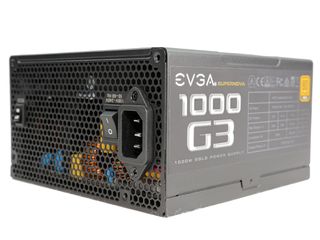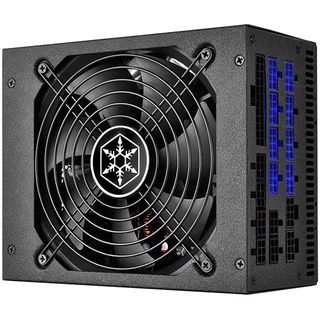EVGA SuperNOVA 1000 G3 PSU Review
We already reviewed the SuperNOVA 850 G3, which left a good impression on us. Today, we're looking at the 1000 G3, this family's current flagship model. It's a physically diminutive PSU that offers high performance in every area.
Why you can trust Tom's Hardware
Load Regulation, Hold-Up Time, And Inrush Current
To learn more about our PSU tests and methodology, please check out How We Test Power Supply Units.
Primary Rails And 5VSB Load Regulation
Load Regulation testing is detailed here.








Hold-Up Time
Our hold-up time tests are described in detail here.







The hold-up time we measured is notably higher than what is required. Further, the power-good signal is accurate.
Inrush Current
For details on our inrush current testing, please click here.


The inrush current at 115V is quite low for a 1kW PSU, though it goes through the roof with 230V.
Load Regulation And Efficiency Measurements
The first set of tests reveals the stability of the voltage rails and the SuperNOVA 1000 G3's efficiency. The applied load equals (approximately) 10 to 110 percent of the PSU's maximum load in increments of 10 percentage points.
We conducted two additional tests. During the first, we stressed the two minor rails (5V and 3.3V) with a high load, while the load at +12V was only 0.1A. This test reveals whether a PSU supports Intel's C6/C7 power states or not. In the second test, we determined the maximum load the +12V rail could handle with minimal load on the minor rails.
| Test # | 12V | 5V | 3.3V | 5VSB | DC/AC (Watts) | Efficiency | Fan Speed | Fan Noise | Temps (In/Out) | PF/AC Volts |
|---|---|---|---|---|---|---|---|---|---|---|
| 1 | 6.414A | 1.993A | 1.988A | 0.987A | 99.802 | 87.168% | 1682 RPM | 45.2 dB(A) | 38.17°C | 0.974 |
| 12.195V | 5.017V | 3.312V | 5.065V | 114.494 | 40.60°C | 115.04V | ||||
| 2 | 13.855A | 2.983A | 2.985A | 1.188A | 199.711 | 90.239% | 1697 RPM | 45.4 dB(A) | 38.99°C | 0.977 |
| 12.187V | 5.017V | 3.312V | 5.057V | 221.313 | 42.14°C | 115.04V | ||||
| 3 | 21.660A | 3.487A | 3.500A | 1.385A | 299.876 | 91.228% | 1728 RPM | 45.7 dB(A) | 39.45°C | 0.985 |
| 12.179V | 5.017V | 3.312V | 5.049V | 328.712 | 43.34°C | 115.04V | ||||
| 4 | 29.459A | 3.983A | 3.985A | 1.583A | 399.728 | 91.457% | 1761 RPM | 46.1 dB(A) | 40.01°C | 0.990 |
| 12.172V | 5.015V | 3.311V | 5.043V | 437.065 | 44.69°C | 115.04V | ||||
| 5 | 36.916A | 4.977A | 4.981A | 1.786A | 499.678 | 91.244% | 1794 RPM | 46.6 dB(A) | 41.02°C | 0.993 |
| 12.169V | 5.014V | 3.312V | 5.036V | 547.631 | 46.53°C | 115.04V | ||||
| 6 | 44.382A | 5.982A | 5.974A | 1.985A | 599.640 | 90.802% | 1829 RPM | 47.0 dB(A) | 42.11°C | 0.994 |
| 12.164V | 5.015V | 3.313V | 5.030V | 660.385 | 47.81°C | 115.04V | ||||
| 7 | 51.846A | 6.983A | 6.972A | 2.191A | 699.559 | 90.080% | 1934 RPM | 47.9 dB(A) | 43.37°C | 0.995 |
| 12.160V | 5.014V | 3.313V | 5.021V | 776.595 | 49.84°C | 115.04V | ||||
| 8 | 59.326A | 7.976A | 7.965A | 2.392A | 799.489 | 89.407% | 2027 RPM | 49.0 dB(A) | 45.69°C | 0.996 |
| 12.155V | 5.015V | 3.314V | 5.011V | 894.214 | 53.26°C | 115.32V | ||||
| 9 | 67.228A | 8.479A | 8.480A | 2.396A | 899.485 | 88.520% | 2072 RPM | 50.5 dB(A) | 45.89°C | 0.996 |
| 12.151V | 5.013V | 3.313V | 5.007V | 1016.140 | 55.05°C | 115.06V | ||||
| 10 | 74.901A | 8.983A | 8.965A | 3.004A | 999.378 | 87.520% | 2072 RPM | 50.5 dB(A) | 46.74°C | 0.996 |
| 12.145V | 5.012V | 3.312V | 4.990V | 1141.880 | 57.33°C | 115.08V | ||||
| 11 | 83.171A | 8.990A | 8.970A | 3.003A | 1099.142 | 86.307% | 2072 RPM | 50.5 dB(A) | 49.22°C | 0.996 |
| 12.137V | 5.009V | 3.310V | 4.986V | 1273.530 | 61.45°C | 115.07V | ||||
| CL1 | 0.099A | 14.025A | 14.005A | 0.004A | 118.843 | 82.943% | 1995 RPM | 48.7 dB(A) | 44.12°C | 0.969 |
| 12.181V | 5.046V | 3.345V | 5.078V | 143.283 | 48.47°C | 115.09V | ||||
| CL2 | 83.253A | 1.003A | 1.003A | 1.002A | 1024.299 | 87.837% | 2084 RPM | 50.5 dB(A) | 47.72°C | 0.996 |
| 12.143V | 4.992V | 3.292V | 5.039V | 1166.140 | 58.51°C | 115.08V |
Load regulation is superb, with nearly no voltage drop at 3.3V and minimal drop at +12V and 5V. Efficiency is high as well, easily meeting the 80 PLUS Gold requirements. It would be nice to see efficiency higher than 88% under a full load, though.
The major downside of this unit, which we kind of expected given our experience with the 850 G3, is its noise output even under light loads. Although we pushed the SuperNOVA 1000 G3 hard by applying high temperatures inside of our hotbox, and it proved it can deliver more than its rated capacity above 49°C ambient, we were hoping for a less aggressive fan profile. Unfortunately, the small PCB restricts airflow, and the small fan has to rotate at high speeds in order to move enough air.
Current page: Load Regulation, Hold-Up Time, And Inrush Current
Prev Page A Look Inside And Component Analysis Next Page Efficiency, Temperature, And NoiseStay on the Cutting Edge
Join the experts who read Tom's Hardware for the inside track on enthusiast PC tech news — and have for over 25 years. We'll send breaking news and in-depth reviews of CPUs, GPUs, AI, maker hardware and more straight to your inbox.
Aris Mpitziopoulos is a Contributing Editor at Tom's Hardware US, covering PSUs.
-
powernod 140$. Exactly the same cost with Corsair's RMx1000 current pricing. Not sure which unit i would choose between those 2.Reply -
BugariaM Nice.Reply
>>>The 1000 G3's single bulk cap is provided by Chemi-Con (400V, 820uF, 2000h @ 105°C, CE)
Strangely, but I did not find "CE" series of capacitors in the Nippon Chemi-Con catalog -
10tacle Wow. The price point of this and overall performance makes this a serious player even for those who were in the market for nothing more than 850W gold or even platinum PSUs. So many people out there say "you don't need more than a xxxW power supply for your build." I like to buy based on <60% of calculated max load use of my build for less fan noise, heat output, and higher efficiency wall draw.Reply
Buying a gold 600W PSU when my rig uses 500W for example does not make much sense to me. I'd prefer to spend a little more and buy a gold 850W ($110USD vs. $130USD in the example of these two 650 & 850 G3 series on NewEgg right now). Not only for a higher efficiency operation as described above, but for future headroom growth. But I understand many do not think that and look to save a few dollars everywhere...one being on the PSU. -
10tacle Reply19478429 said:140$. Exactly the same cost with Corsair's RMx1000 current pricing. Not sure which unit i would choose between those 2.
Keep in mind when comparing the RM1000x that it was introduced at $180 in November 2015 and it took nearly a year to see the prices drop down below $150. The EVGA was originally released at $170 and has only been out for four months. Also keep in mind that the Corsair is marketed more for silent operation (drawback to that shown below).
If none of the drawbacks described and shown here do not bother you, and if overall "hot" efficiency and exhaust temperature are among top priorities for you, then the EVGA is the better performer. Average efficiency result of 7 load line tests, and the average exhaust temps under each test:
EVGA - 88.571%, 45.0C
Corsair - 87.857%, 49.8C
^^While the <1% efficiency difference is nominal and will not be seen on your monthly power bill, that nearly 5C difference coming out can make a slight difference in the temperature of your room in the summer. So the Corsair being quieter has a drawback.
http://www.jonnyguru.com/modules.php?name=NDReviews&op=Story4&reid=494 (EVGA)
http://www.jonnyguru.com/modules.php?name=NDReviews&op=Story4&reid=449 (Corsair)
-
Co BIY I would have liked to see the EVGA 1000 G2 in the performance tables as well. Both to see the generational improvement and to make a value comparison while both units are on the market.Reply
Is EVGA stopping production of the G2 series ? -
hst101rox 10TACLE, if the efficiency of the EVGA and the Corsair are nearly identical, the ~5 degree C temp difference could be just from the amount of airflow being less in the Corsair. Power consumption is the only thing that equates to BTUs, heat.Reply -
10tacle Reply19479497 said:10TACLE, if the efficiency of the EVGA and the Corsair are nearly identical, the ~5 degree C temp difference could be just from the amount of airflow being less in the Corsair. Power consumption is the only thing that equates to BTUs, heat.
That's why I stated the downside to the Corsair is the hotter air coming out the back. Same thing with a video card: you have to sacrifice more heat output for a quieter fan speed.
-
Aris_Mp I don't have 115V test results (but only 230V) for the G2s, so I couldn't add them to the graphs.Reply -
Co BIY "We didn't get any OCP results because our unit died during the OPP test, meaning either that this particular sample had a problem or OPP is set very high."Reply
Seems like this would be a big deal ?
Maybe at least one bullet in the Con column. -
Aris_Mp I have another one here, which come late, to test. If it dies as well then I will update the con list.Reply


